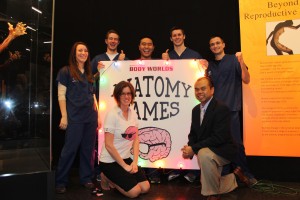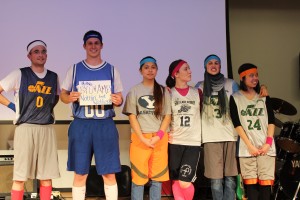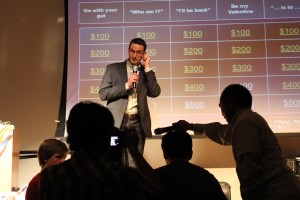
BYU students participated in BODY WORLDS’ first Anatomy Games competition at The Leonardo Museum on Feb. 5. They didn’t take first place, but they taught exhibits, worked with a high school team and learned more about pursuing medical work.
Jenie Skoy, communications manager of Gunther Von Hagen’s BODY WORLDS, said they invited high schools and colleges in Utah to send their brightest anatomy students to compete in a series of spirited quiz nights.
Top anatomy researchers in Utah and the West also participated in the Games. Anatomists included David Morton, director of the anatomy lab at the Utah School of Medicine; University of Utah anatomy professor Mark Nielsen; and BYU anatomy professor Dr. Jon Wisco.
BYU anatomy students Sam Holley, Aimee Hodson and Alexander Martin competed, with alternates Matthew Bird and Marc Matsumura.

Utah) sport retro jerseys at the Anatomy Games. (Jenie Skoy)
Wisco was one of the anatomists who helped with the games. He created the Jeopardy/Family Feud-style setup for the event and worked as a games referee that evening.
The games culminated in two quiz nights: The first night, on Jan. 30, designed a high-school edition in which nine high schools from around Utah competed to see which high school students paired up with college students for the final round.
The Jeopardy-style game was a series of extensive and rigorous and multimedia questions created by Morton.
The BYU and Ames team members, who called themselves The Netters, wore retro sports jerseys and won the “Most Stylin’ Team Outfit” award.
Anatomy Games contestants also taught inside the exhibit. BYU student Marc Matsumura worked inside the BODY WORLDS exhibit to teach guests about human anatomy using the 15 whole bodies inside and the 20 specimens.
“We wanted these events to help recognize those studious students who possess a love for studying human anatomy, as well as helping connect them with older students and professionals who will inspire their future aspirations in the medical industry,” said Jenie Skoy.
Local ophthalmologist Dr. Bala Ambati, the Guinness Book of World Record’s reigning Youngest Dr. in the World, visited anatomy students and also led a tour. Ambati graduated from medical school at age 17 and gave contestants a pep talk about working hard. The winners of Anatomy Games, Utah/Timpanogos, will attend a dinner with Ambati.

Skoy said she couldn’t have done this event without the help of three world-class anatomists, including BYU professor Jon Wisco. As part of the games, Morton, Nielsen and Wisco taught anatomy inside the Cycle of Life exhibit to visitors and contestants of Anatomy Games.
Wisco is using new technology to teach anatomy; a dynamic 3D printing program prints brains and other organs for the students to work with.
The BYU lab is also building its own plastination program, because so many students go through the specimen materials that they just fall apart. Wisco said cranial nerves and other materials get “pulled and tugged, and they don’t last very long.”
Utah has some of the best anatomists in the West; some say real cadavers are the best teaching tools for students.
“A cadaver is a medical student’s first patient,” Morton said. He is helping Wisco map the muscles and nerve fibers at every synovial joint in the body.
Wisco will also be working with a physician from Africa in March on a travel exchange study program. In Africa researchers have a serious shortage of access to cadavers because of the threat of AIDS and Ebola. This physician will learn how to use 3D printers to create organs and how to “plastinate.”




